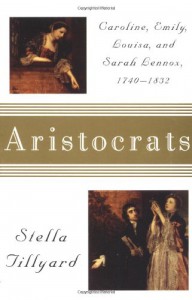Aristocrats by Stella Tillyard

This is a well-researched and engagingly written group biography of four sisters, daughters of a duke and great-granddaughters of King Charles II of England and one of his mistresses. Caroline, Emily, Louisa and Sarah Lennox all wrote to each other (and third parties) constantly, leaving a trove of correspondence that the author used as material for this book. Tillyard brings the four of them – and the people and places around them – to life with vivid descriptions, and seems to have a strong handle on the personalities and psychologies of each of the sisters. She also includes a lot of background information on their world where it enhances the story: from everyday details about the dozens of departments involved in the running of an aristocratic household, to background on the Irish Rebellion of 1798, in which Emily’s son Edward Fitzgerald was a leader.
It is a well-told story and makes for much quicker reading that Tillyard’s A Royal Affair, splitting its attention between human feelings and relationships on the one hand, and history on the other. While none of the sisters seem to have contributed much to history in their own right or really stepped out of the roles of wives/mothers/lovers, they did have pretty interesting love lives: one eloped and was temporarily estranged from the family; one began an affair with her children’s tutor and later married him across class lines after her first husband’s death; one was George III’s crush, before hastily getting into an unhappy marriage followed by a public divorce. In her preface, Tillyard emphasizes the intimacy of the sisters’ letters, allowing modern readers to connect with them even across a great gap in time, and this is certainly true.
The subtitle is a little misleading as to the time period, though. About 80% of the book focuses on the period from the 1740s through 1770s; in my edition, it’s not until page 397 out of 426 that we hit the 19th century. A couple of other better publishing decisions might have been made, in that the chapters are way too long and might have been broken up for easier reading, and there’s no family tree, which becomes especially confusing when talking about Emily’s life with her 22 children. Even a list of everyone’s kids with birth and death dates would have been extremely helpful.
I’m also never happy to see a nonfiction author who doesn’t cite the sources of specific facts. I understand that this is original research and the author does list her sources generally in the back, including mostly archival sources. Still.
In the end, I enjoyed reading this book and found it quite interesting, but never found myself with much to say about it. Maybe it’s because it’s largely a domestic history, not too different from stories that could be told about many other families; its four subjects were ultra-wealthy and privileged, but in the end we are reading their story rather than someone else’s simply because they happened to leave more writings behind. Maybe it’s because Tillyard did such a good job bringing her subjects’ personalities to life that, while I enjoyed reading about the sisters’ complex personalities and admired each of them at various points, I ultimately didn’t like them very much; they all come across as rather self-satisfied and entitled in the end. So I didn’t love the book, but I did like it, and it has a lot to recommend it whether your interest is anthropological or escapist.





